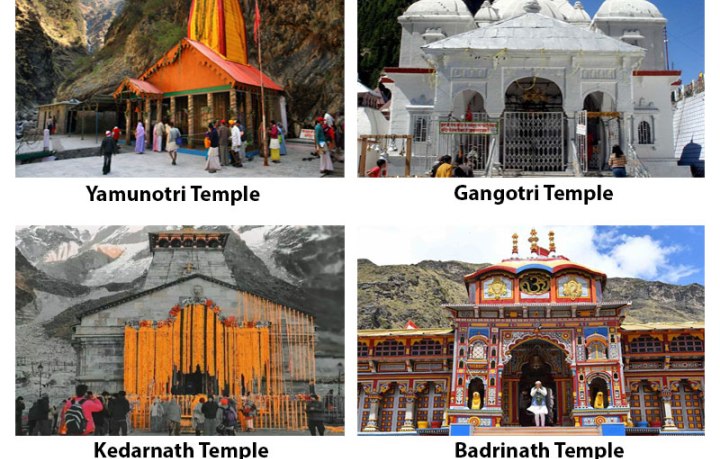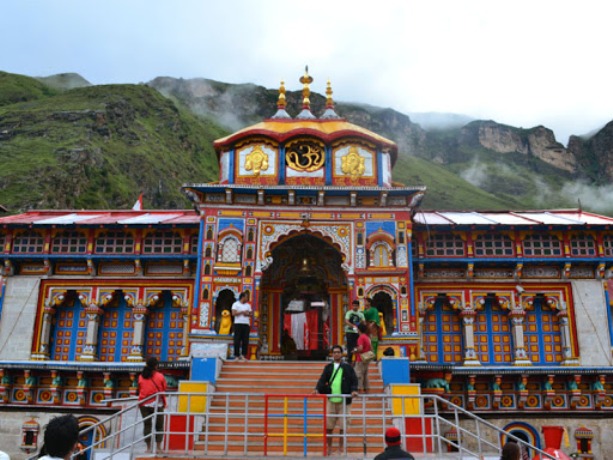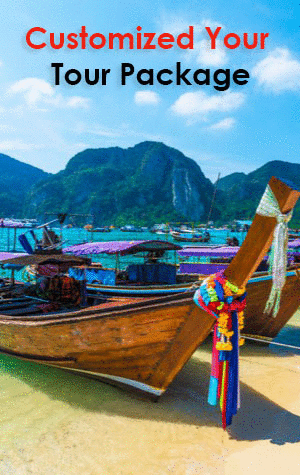
The Chardham Yatra refers to a pilgrimage to four sacred shrines in the Indian state of Uttarakhand. These four sites, Yamunotri, Gangotri, Kedarnath, and Badrinath, collectively form the Chardham, and the yatra (journey) is considered one of the holiest for Hindus. Here are details about each of the Chardham destinations.
1. Yamunotri Dham :- Yamunotri Dham is one of the four holy shrines of Hinduism that is located in the western region of Garhwal Himalayas at an altitude of 3,291 meters in Uttarkashi district, Uttarakhand . The temple at Yamunotri is dedicated to Yamuna, the second-most sacred river after the Ganges . It is believed that a dip in River Yamuna is said to protect one from untimely death .
Yamunotri Temple:-Start your Chardham Yatra with Yamunotri, dedicated to Goddess Yamuna. The temple is situated at an altitude of about 3,293 meters in the Garhwal Himalayas.
Surya Kund and Divya Shila:-Visit Surya Kund, a hot water spring, and perform a ritual bath. Also, see Divya Shila, a rock pillar worshipped before entering the temple.
Janki Chatti:-Enroute, stop at Janki Chatti for a relaxing break and to enjoy the scenic surroundings.
2. Gangotri Dham :- Gangotri Dham is one of the four holy shrines of Hinduism that is located in the Uttarkashi district of Uttarakhand. It is the origin of the holy River Ganga and is dedicated to Goddess Ganga. According to Hindu mythology, it is believed that the River Ganga took birth here when Lord Shiva released the mighty river from his locks of hair.
Gangotri Temple:-Travel to Gangotri, the origin of the River Ganga, and visit the Gangotri Temple. The temple is perched at an altitude of approximately 3,100 meters.
Ganga Aarti at Gangotri Ghat:-Attend the evening Ganga Aarti on the banks of the Bhagirathi River. It's a spiritual and serene experience.
Submerged Shivling:-Visit the submerged Shivling, a natural rock that is said to be the place where Lord Shiva received Ganga in his matted locks.
3. Kedarnath Dham :- The Kedarnath temple has exquisite architecture and is built of extremely large but evenly shaped grey stone slabs. A conical rock formation inside the temple is worshipped as Lord Shiva in his “Sadashiva” form. Behind the Kedarnath temple, stand the Kedarnath peak, Kedar Dome and other Himalayan peaks.
Kedarnath Temple:-Proceed to Kedarnath, one of the twelve Jyotirlingas, and visit the Kedarnath Temple. The temple is nestled amidst the Garhwal Himalayas at an altitude of around 3,583 meters.
Adi Shankaracharya Samadhi:-Pay homage at the Samadhi of Adi Shankaracharya, located behind the Kedarnath Temple.
Bhairon Temple:-Optionally, trek to the Bhairon Temple for panoramic views of the Kedarnath Valley.
4. Badrinath Dham :- Badrinath Dham is one of the four holy shrines of Hinduism that is located in the Chamoli district of Uttarakhand . It is dedicated to Lord Vishnu and is one of the 108 Divya Desams dedicated to Vishnu . The temple is situated on the banks of the Alaknanda River and is surrounded by lofty Himalayan peaks, dense forests, and pristine valleys.
Badrinath Temple:-Conclude your Chardham Yatra at Badrinath, dedicated to Lord Vishnu. The temple is located at an altitude of about 3,133 meters.
Mana Village:-Visit Mana Village, the last village before the Indo-Tibetan border. It has cultural and mythological significance.
Tapt Kund and Surya Kund:-Take a dip in the Tapt Kund, a hot water spring, and visit the Surya Kund nearby.
Badrinath Temple Aarti:-Attend the evening Aarti at the Badrinath Temple. The divine atmosphere during the Aarti is a spiritual highlight.
TOUR DESTINATION-:
Haridwar - Barkot - Yamunotri - Uttarkashi - Gangotri - Guptkashi - Kedarnath - Badrinath - Joshimath - Pipalkoti - Rudraprayag - Srinagar - Rishikesh - Haridwar
TOUR DURATION-:
8 Nights / 9 Days
ITINERARY-:
DAY 01: HARIDWAR – BARKOT (220KMS/7HR
Welcome to Chardham yatra. Arrival from railway station assist by SYPL executive and Drive to Barkot via Dehradun & Mussoorie. Enroute visit Kempty Fall and others later drive straight to your Hotel for night halt.
DAY 02: BARKOT – YAMUNOTRI BARKOT {36KMS
DRIVE & 6KMS TREK (ONE SIDE)}
Drive to Hanuman
Chatti, for Janki chatti (It helps to reduce the trek upto 8 kms), trek start
from here to Yamunotri (6kms). Either by walk or by horse or by Doli at own
cost. Arr. Yamunotri, One can cook rice by packing it in a cloth and dipping it
in the hot water of the hot kund. Pilgrims take this cooked rice home as
“Prasad”. Here near the temple “Pooja” can be offered to Divya Shila, after
taking bath in Jamunabai Kund’s warn water and having “Darshan” of pious “Yamunaji”
returning to Hanumanchatti. Later drive back to Barkot. Overnight stay at
Hotel.
Hanuman Chatti:
The confluence of Hanuman Ganga & Yamuna River. Yamunotri Temple: Maharani
Gularia of Jaipur built the temple in the 19th Century. It was destroyed twice in
the present century and rebuilt again.
Surya Kund:
There are a Number of thermal springs in the vicinity of the temple, which
flows into numerous pools. The most important of these is Surya Kund.
Divya Shila: A rock pillar, worshipped before entering the Yamunotri Temple.
DAY 03: BARKOT – UTTARKASHI (100KMS/4HR)
Drive to Uttarkashi on arrival Check in the Hotel, Later visit Vishwanath Temple .Night Halt. Uttarkashi: Situated at the bank of river Bhagirathi. The temple of Lord Vishwanath is located here where a massive iron trident is erected. The other important temples situated here are Annapurna Devi Temple, Ekadash Rudra, Bhairav, Gyaneshwar and Goddess Kuteti Devi.
DAY 04: UTTARKASHI – GANGOTRI – UTTARKASHI
(100KMS/3HR EACH SIDE)
We proceed to Gangotri (3048 mts), enroute we enjoy picturesque Harsil village, Bhagirathi River and the most magnificent view of the Himalayas . After Gangotri Darshan we return to Uttarkashi. Overnight stay at Uttarkashi. Gangotri Temple: The temple, constructed by the Gorkha General Amar Singh Thapa in the 18th Century, is situated on the right bank of Bhagirathi. Submerged Shivling: Submerged in the river, this natural rock Shivling is the place where, according to mythology Lord Shiva sat when he received the Ganga in his matted lock. It is visible in winter months when water level decreases. Kedar Ganga Sangam: Around 100 Yards from the Ganga Temple flows the river Kedar Ganga. Starting from the Kedar Valley, this river meets the Bhagirathi on its left bank.
DAY 05: UTTARKASHI- GUPTKASHI
(235KMS/9HR)
Early morning, drive to Guptkashi .On Arrival Check in Hotel, night halt.
DAY 06: GUPTKASHI – KEDARNATH- GUPTAKASHI (18KMS TREK)
Morning drive to Sonprayag, Trek start from Sonprayag to Kedarnath (3584 mts) on foot or on by pony / Doli. Tour members should carry personal medicines, heavy woolen, tolietteries and clothes for an overnight halt at Kedarnath. Check in Hotel. Later visit Kedarnath Temple. Later back to Guptakashi. Night halt. Gaurikund: At a distance of 5kms from Sonprayag and at an altitude of 1982 meters, one can take bath in the hot water pond here and visit the Gauri Temple. This is the place where Goddess Parvathi meditated to attain Lord Shiva. It is the base for a trek to Kedarnath. Kedarnath: The Kedarnath shrine, one of the 12 jyotirlingas of Lord Shiva, is a scenic spot situated, against the backdrop of the majestic Kedarnath range. Kedar is another name of Lord Shiva, the protector and the destroyer. According to legend, the Pandavas after having won over the Kaurava in the Kurukshetra war, felt guilty of having killed their own brothers and sought the blessings of Lord Shiva for redemption. He eluded them repeatedly and while fleeing took refuge at Kedarnath in the form of a bull. On being followed he dived into the ground, leaving his hump on the surface. The remaining portions of Lord Shiva appeared at four other places and are worshipped there as his manifestations. The arms appeared at Tungnath, the face at Rudranath, the belly at Madhmaheshwar and his locks (hair) with head at Kalpeshwar. Kedarnath and the four above-mentioned shrines are treated as Panch Kedar.
DAY 07: GUPTKASHI – BADRINATH
(215KMS/9HR)
Drive to
Badrinath via Joshimath. Check in Hotel. Later at evening visit Badrinath
Temple for Aarti. Overnight stay. Badrinath one of the ‘Four Dhams’ is one of
the most celebrated pilgrimage spots of the country and is situated at an
elevation of 3,133 meters, guarded on either side by the two mountain ranges
known as Nar & Narayan with the towering Neelkanth Peak providing a
splendid backdrop. This revered spot was once carpeted with wild berries. Thus
the place got the name “Badri van”, meaning “forest of berries”.
Tapt Kund :
Natural thermal springs on the bank of the river Alaknanda, where it is
customary to bathe before entering the Badrinath temple.
Narad Kund : A
recess in the river, near Tapt Kund, forming a pool from where the Badrinath
idol was recovered.
Brahama Kapal :
A flat platform on the bank of river Alaknanda. Hindus perform proppitiating
rites for their deceased ancestors.
Sheshnetra :
1.5kms. away is a boulder having an impression of the legendary serpent, better
known as the Sheshnag’s eye.
Charanpaduka :
3kms. away is a beautiful meadow where the footprint of Lord Vishnu is seen on
a boulder.
Mata Murty Temple : Devoted to the mother of Sri Badrinathji. Other important temples include Sesh Netra Temple , Urvashi Temple and Charanpaduka.
Vasudhara : As
the name suggests, vasudhara is a magnificent water fall. This place is 5 kms.
from Badrinath out of which 2 kms. is motorable upto Mana.
Bhim Pul : On
the other side of Mana village, a massive rock forming a natural bridge, lies
over the roaring Saraswati river. It presents a spectacular view of water
thundering down through the narrow passage under the rock and is believed to
have been placed there by Bhim, the second eldest among the five Pandava
brothers.
Vyas Gufa (cave) : Near Mana Village, this is a rock-cave where Ved Vyas is believed to have composed the Mahabharata and the pauranic commentaries.
DAY 08: BADRINATH – JOSHIMATH – PIPALKOTI ( 75 KMS/2-3HR)
Early morning, pilgrims after having a bath in the Taptkund have the Darshan of Badrivishal. Brahamakamal is significant for Pinddan Shraddh of ancestors (Pitrus). There are other interesting sightseeing spot like Mana, Vyas Gufa, Maatamoorti, Charanpaduka, Bhimkund and the “Mukh” of the Saraswati River . Just within the three kms of Badrinathjee. Later drive back to Rudraprayag via Joshimath. Check in Hotel. Joshimath is situated on the slopes above the confluence of Alaknanda and Dhauliganga. Of the four ‘Maths’ established by Adi Shankaracharya, Joshimath is in the Badrinath to Joshimath and installed in the temple for people to worship. There are many temples in the township most important is the temple of Nir Singh in commotion of Lord Vishnu. The left arm of this deity is with time and the popular belief holds that the day the the arm completely withers Badrinath valley will cease to exist and the Gods will transfer the residence into the neighboring Niti Valley at Bhavishya Badri. Joshimath is connected by regular bus service to Rishikesh, Haridwar, Badrinath and many other centres in the region.
DAY 09: PIPALKOTI - RISHIKESH – HARIDWAR (236 KMS/ 6-7 HR)
Morning drive
back to Haridwar. Enroot visit Rishikesh, the ‘place of sages’ is a celebrated
spiritual town on the bank of Ganga and is surrounded by Shivalik range of the
Himalayas on three sides. It is said that when Raibhya Rishi did hard penances,
God appeared by the name of ” Hrishikesh ” and this area hence firth came to be
known as Rishikesh. Temples & Sight Seeing – Laxman Jhulla, Ram Jhulla,
Triveni Ghat, Bharat Mandir, Ashram, Parmarth Ashram later drive to Haridwar.
Drop at railway station.
PACKAGE INCLUDE:-
- Ø Meeting and assistance on arrival.
- Ø Accommodations in Double/ Triple
Occupancy
- Ø Transport by reserved Cab
- Ø Daily fixed Menu breakfast &
dinner.
- Ø Driver Bata, Toll tax and parking.
- Ø AC will not work in hill area (after Haridwar).
PACAKAGE EXCLUDE:-
- Ø Air fare / train fare.
- Ø Coolie / porter charges.
- Ø Camera charges.
- Ø Donations at temples.
- Ø Helicopter for Kedarnath
- Ø Extended stay or travelling due to
any reason.
- ØAny meals other than those specified
in Tour Cost Includes.
- Ø Expenses of personal nature such as
tips, telephone calls, laundry, liquor etc.
- Ø Any other item not specified in ‘Tour
cost includes.
- Ø Guide & Entrance fees during
sightseeing.


.jpg)

| S.No. | No. of Pax | Cab | Cost/Pax |
|---|---|---|---|
| 1 | 12 | Tempo Traveler | 21999 |
| 2 | 7 | Innova | 24999 |
| 3 | 6 | Ertiga | 23999 |
| 4 | 4 | Dzire/Indigo | 24999 |
